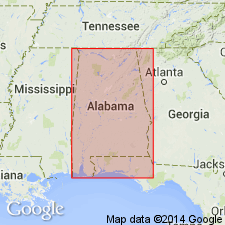
- Usage in publication:
-
- Brewer phyllite member
- Modifications:
-
- Named
- Dominant lithology:
-
- Phyllite
- AAPG geologic province:
-
- Piedmont-Blue Ridge province
Summary:
Brewer phyllite member of Talladega slate named in this report for Brewer School in Chilton Co., eastern AL. Consists of sericitic phyllite of deep purplish or chocolate color, occurring a few hundred ft above Sawyer limestone member. Maximum thickness 1,000+/-ft. Age given as Precambrian or Paleozoic.
Source: GNU records (USGS DDS-6; Reston GNULEX).

- Usage in publication:
-
- Brewer phyllite*
- Modifications:
-
- Revised
- AAPG geologic province:
-
- Piedmont-Blue Ridge province
Summary:
Rank of unit raised to formation. Overlies Waxahatchee slate; underlies Wash Creek slate (new). Thickness 200 to 500 ft.
Source: GNU records (USGS DDS-6; Reston GNULEX).
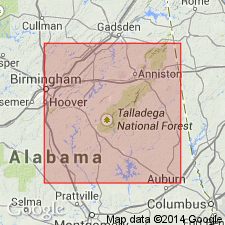
- Usage in publication:
-
- Brewer Phyllite
- Modifications:
-
- Revised
- AAPG geologic province:
-
- Piedmont-Blue Ridge province
Summary:
Brewer Phyllite here assigned to newly named Kahatchee Mountain Group.
Source: GNU records (USGS DDS-6; Reston GNULEX).
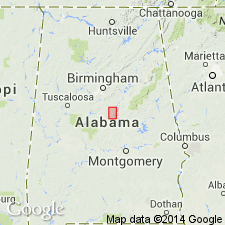
- Usage in publication:
-
- Brewer Formation
- Modifications:
-
- Redescribed
- Dominant lithology:
-
- Phyllite
- Sandstone
- Siltstone
- Limestone
- AAPG geologic province:
-
- Piedmont-Blue Ridge province
Summary:
As defined here, Brewer Formation of Kahatchee Mountain Group is composed not only of distinctive maroon phyllite, but also maroon, micaceous, calcareous, arkosic sandstone and siltstone and feldspathic, hematitic, conglomeratic wacke. Sawyer Limestone Member assigned to base of Brewer. Member was originally assigned to underlying Waxahatchee Formation by Butts (1926). Underlies Stumps Creek Formation. Age given as Early Cambrian.
Source: GNU records (USGS DDS-6; Reston GNULEX).

- Usage in publication:
-
- Brewer Phyllite
- Modifications:
-
- Overview
- AAPG geologic province:
-
- Piedmont-Blue Ridge province
Summary:
Brewer Phyllite of Kahatchee Mountain Group described as alternating layers of grayish-yellow-green to grayish-green and very dark-red clayey and silty phyllite or slate, interbedded with metasiltstone, quartzite (locally conglomeratic) and metalimestone and metadolomite near the base (Sawyer Limestone Member). Beds range from a fraction of an inch to as much as 10 ft thick and are commonly graded. The upper contact with the Wash Creek Slate is gradational. Occurs in the northern Piedmont. Age is generalized as Precambrian and Paleozoic.
Source: GNU records (USGS DDS-6; Reston GNULEX).
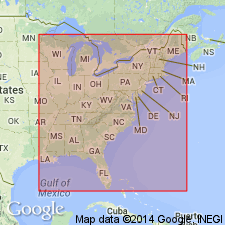
- Usage in publication:
-
- Brewer Phyllite*
- Modifications:
-
- Overview
- AAPG geologic province:
-
- Piedmont-Blue Ridge province
Summary:
Authors follow usage of Tull (1982) as Kahatchee Mountain Group of Talladega block in AL. [Formations within Kahatchee Mountain are not discussed individually, but usage is inferred.] Base of Kahatchee Mountain is not exposed, nor are any crystalline basement rocks exposed in Talladega block in AL. To the northeast in GA, Kahatchee Mountain Group may unconformably overlie Middle Proterozoic basement (if Mulberry Rock Gneiss proves to be basement). Tull (1982) suggests that Kahatchee Mountain rocks are roughly equivalent to Ocoee Supergroup and Chilhowee Group rocks. McConnell and Abrams (1984) portray northeastern end of Talladega belt, which would be Kahatchee Mountain Group, as continuous into Great Smoky Group. More recently, archaeocyathids have been found in Jumbo Dolomite (McKinney and others, 1988), which is stratigraphically below Sylacauga Marble Group of Tull (1982) and its base is interlayered with lithologies of Kahatchee Mountain Group. Jumbo is correlated with Early Cambrian Shady Dolomite of Valley and Ridge province. The Kahatchee Mountain rocks, like Ocoee rocks, are volcanic-free.
Source: GNU records (USGS DDS-6; Reston GNULEX).
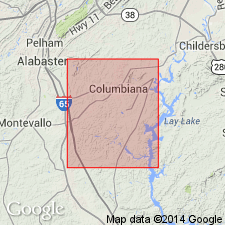
- Usage in publication:
-
- Brewer Phyllite
- Modifications:
-
- Overview
- AAPG geologic province:
-
- Piedmont-Blue Ridge province
Summary:
As defined here, the Brewer Phyllite is lithologically the most heterogeneous formation in the Kahatchee Mountain Group. The formation not only includes the distinctive very dusky-red phyllite recognized by Butts, but very dusky-red micaceous calcareous arkosic sandstone and siltstone, feldspathic hematitic conglomeratic wacke, very dusky-red micaceous feldspathic arenaceous siltstone or wacke, dolomitic marble, and conglomeratic sandstone. The Brewer includes the previously defined Sawyer Limestone Member and the conglomeratic sandstone member. Thickness is variable across the region. Reaches a maximum of 3,051 ft in the hinge region of the Columbiana syncline. Thins to 1,88880 ft to the southeast and southwest. Overlies the newly named Long Branch Sandstone Member of the Waxahatchee Slate and underlies the undifferentiated lower part of the Stumps Creek Formation, which lies below the newly named Watson Creek Member. Age of the Brewer Phyllite in this report is Early Cambrian(?).
Source: GNU records (USGS DDS-6; Reston GNULEX).
For more information, please contact Nancy Stamm, Geologic Names Committee Secretary.
Asterisk (*) indicates published by U.S. Geological Survey authors.
"No current usage" (†) implies that a name has been abandoned or has fallen into disuse. Former usage and, if known, replacement name given in parentheses ( ).
Slash (/) indicates name conflicts with nomenclatural guidelines (CSN, 1933; ACSN, 1961, 1970; NACSN, 1983, 2005, 2021). May be explained within brackets ([ ]).

